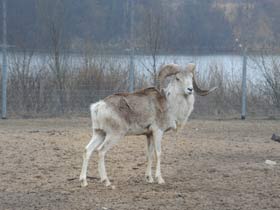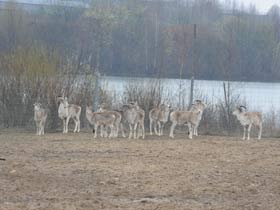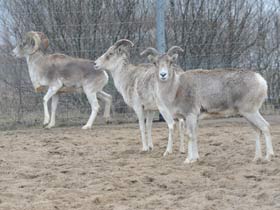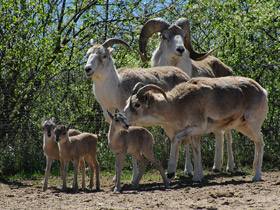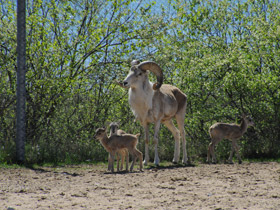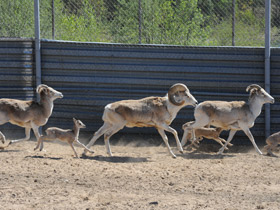The Marco Polo sheep Поло Ovis ammon polii
Mountain sheep belong to the group of two-toed ungulates that are taxonomically close to the mountain goats. Scientists have not yet reached a consensus regarding numbers and taxonomy of the sheep. Mountain sheep sizes range from medium to large. These ungulates have longer legs and more elegant bodies than domestic sheep but their limbs are still shorter than the limbs of the mountain goats. The sheep are heavier and stockier compared to mountain goats. And the most distinctive feature of the sheep is their horns. Sheep’s horns are massive, spiraled, and curled close to the face, though they may flare widely outward. The horns carry horizontal ribs but they are not as prominent as are those of the goat horns. Besides, sheep do not have beards and rarely feature fleshy appendages under their throats. Despite all the differences, some species, for instance, the Barbary sheep and the blue sheep, are actually more closely related to goats than to true sheep. The range of the mountain sheep is restricted to the Northern Hemisphere where they are widely distributed in alpine regions. Asia could be considered the hot spot of their diversity: the sheep are found in the mountain ranges of the Caucasus, Pamir, Tan Shan, Altai, Tibet, the Himalayas, Transbaikal, Siberia, and Kamchatka Peninsula; they are also encountered alone the Pacific Coast of North America, and in Morocco and Tunisia in Northern Africa. Mountain sheep prefer to stay in subalpine mountain zones, and are usually found at lower altitudes than mountain goats. Mountain sheep are sedentary animals but they may make seasonal migrations, descending to the foothills in winter, and moving up to the mountain peaks in summer. In summer, the herds of the mountain sheep comprise 10 to 30 individuals but by winter time, their herds may number 100 and even up to 1,000 animals (which also presents the difference between sheep and goats since the latter never form such numerous herds). Unlike domestic sheep known for their torpor, wild sheep are cautious and nimble animals that are always alert, staying on the lookout for potential dangers, and selecting ways of escape that are not accessible for their enemies. Mountain sheep are not as excellent climbers as mountain goats; sheep are not able to move on estremelly steep slopes though they skilfully jump on the rocks 2 meters vertically and 3 to 5 meters horizontally. Mountain sheep feed on grassy plants, giving preference to cereals, though they can survive on lichens, and branches of bushes and trees (oak, maple, pistachio or hornbeam). In the mating season, the males join herds of the females and display. Two males stand in front of each other, advance with threat jump, and then lunge to head butt with skull-jarring force. In spite of the enormous force of the blows, thick frontal bone of these sheep protects the animals, acting as shock absorber. Gestation in sheep females lasts 155 to 170 days, followed by the birth on one lamb (sometimes two lambs are born). The lambs try foraging at the age of one month but they are not weaned until they are six months old. The young start feeding independently in the autumn. Little lambs are very vulnerable though they are frolic and demonstrate perfect jumping abilities while playing.
Humans have always hunted sheep for their meat, fat, and hides. Heads and horns of these animals were ever prized as hunting trophies. Mountain sheep played an important rope in the lives of ancient people and it is not surprising that these animals were domesticated and dispersed all over the world. Mountain sheep became very rare in many areas of their former range, with extensive hunting and degradation of wild habitats being major threats to their survival. Mountain sheep easily adapt to captive environment and successfully breed in captivity; they can interbreed with domestic sheep, producing hybrids.
The Marco Polo sheep (Ovis ammon polii)
The Marco Polo sheep (Ovis ammon polii) is the largest subspecies of argali sheep, named after Marco Polo, a famous explorer who described this ungulate. The Marco Polo sheep is distributed at elevations of 1,200 to 6,100 meters above sea level in mountains and foothills of China, Afghanistan, Tajikistan, and Kyrgyzstan. Both males and females of this sheep have horns, although the horns of the males are significantly larger; horns in some males reach up to 190 cm in length and weigh up to 13% of the entire body weight. Magnificent ridged horns of the Marco Polo sheep have corkscrew shape with rounded combat edges; unfortunately, the horns are highly prized as hunting trophy. These mountain sheep generally avoid forested areas, preferring open spaces, such as steppe valleys in the mountains and foothills, alpine meadows, and rocky outcrops. In summer, argali live on alpine grasslands with abundant grassy vegetation, often descending lower in winter to forage in the pastures with low snow cover. Argali are gregarious animals, living in large single-sex herds that may number up to 100 individuals. During the mating season, the males compete for access to females. After gestation period of 150 to 160 days, females give birth to a litter of one or two lambs. In early spring, just before the birth of the lambs, the female separates from her herd, and finds secluded place in order to give birth and keep the newborns hidden for the first days of their lives. The lambs grow fast; they are nursed for four months, and become completely independent shortly after weaning. Males do not participate in parental care.

















